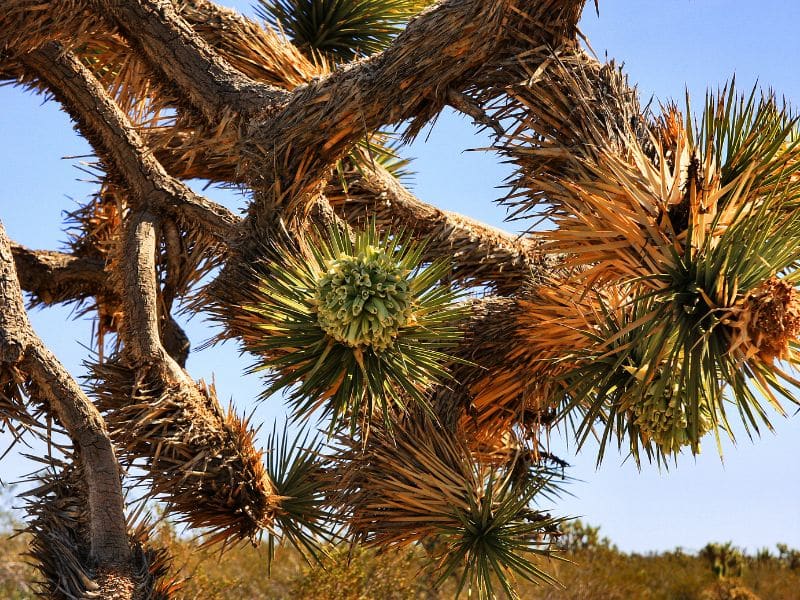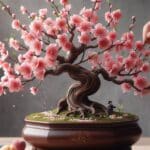Joshua trees (Yucca brevifolia) tend to stand out in landscapes because of their otherworldly appearance. These desert plants have branches with clusters of leaves at their tips, giving the tree a distinctive look.
Because it thrives in the harshest conditions, the tree is often used to symbolize strength and beauty that can arise from dysfunction.
The tree’s unique features and special symbolism often make it very tempting for bonsai enthusiasts to use it in miniature creations. While it is possible to grow a Joshua bonsai, this tree’s unique structure and growth can make the journey a little bit challenging.
For most people, it is much easier to use a similar-looking small succulent, the Sedum multiceps, to recreate the appearance of a mini Joshua tree.
It is, however, entirely possible for you to grow an authentic Yucca brevifolia tree bonsai, and in this guide, we will show you exactly how to do just this.

Plant Facts
| Scientific name | Yucca brevifolia |
| Common names | Joshua tree, Yucca palm, Joshua bonsai, Yucca bonsai, Palm tree yucca |
| Family | Asparagaceae |
| Plant Type | Succulent |
| Height and Width | 3-9 ft. tall (natural), 1–3 ft. tall (bonsai) |
| Origin | Southwestern United States |
| Flower colors | White flowers |
| Foliage color | Light green with straw-colored dead foliage |
| Sun Exposure | Direct sunlight |
| Soil Type & pH | Well-drained, dry, and poor soil conditions |
| Special features | Low Maintenance, Good for Container. |
What Does a Joshua Bonsai Look Like?
Bonsai Joshua trees usually resemble a miniature version of a full-sized Joshua tree. The tree usually has a single trunk from which branches with clusters of leaves expand. As the leaves die, they will keep clinging to the stems or branches, giving the tree a furry appearance with green spikes at the tips. The Joshua tree can also produce bright white, rounded flowers with a foul odor.
Where Does a Joshua Bonsai Tree Grow
The Joshua tree naturally grows in the desert and it prefers these harsh, warm, and dry conditions. A bonsai Joshua tree will need to be kept outdoors in a full sun position throughout the warmer seasons. These trees are not cold tolerant and should be protected from the frost during chilly winters.
How to Grow a Joshua Tree for Bonsai
It can be difficult to keep this tree small and to create an aged appearance for your small tree since the branches are not too easy to manipulate. Unlike other trees, this one doesn’t have growth rings and is instead made up of small fibers. Let’s take a look at how to grow this majestic plant.
Propagation
It isn’t possible to manipulate the branches of a mature Joshua tree. If you want to use it as a bonsai, it is best to start with a young plant.
The Joshua tree can be grown from seed or by harvesting rhizomatous offshoots.
The seeds of this tree are very easy to germinate if you keep it at warmer temperatures of 60 – 70 degrees F.
Since the Joshua tree is a succulent, it is easy to grow from rhizomatous offshoots. You can cut the offshoots from the mother plant, and it will quickly grow new roots.
Soil
These trees require a well-draining soil mixture. You can use succulent potting soil with lots of perlite for your tree. Avoid traditional bonsai soil mixtures because these tend to capture too much moisture and might cause root rot for your dessert plant.
Pruning
These trees will only conform to most bonsai styles if they have branches. Instead, they have spines and pruning can encourage more spines to develop.
The trees can only be slightly modified and are better for upright or informal upright bonsai styles. They don’t produce too many branches and require little to no pruning. The dead foliage should be left on the tree’s branches since this gives the Joshua tree its unique fuzzy appearance.
Repotting and Transplanting
Repotting your bonsai should be done very minimally since these trees don’t like root disturbance. If they are repotted too often, they will likely die. Wait until the tree has outgrown its container before repotting it.
If you do have to repot this tree species, you should be careful about your approach. About one-third of the roots should be pruned away so the tree will remain small and it should be planted in a container with proper drainage.
How to Care for a Miniature Joshua Tree

This type of evergreen bonsai isn’t too hard to grow but it can be a bit challenging to keep it alive when you have it planted in a small container where its resources might be limited. Most growers make the mistake of caring too much for this tree and this can ultimately lead to its death since the Joshua tree fairs best if it is a bit neglected.
Here is a quick look at how to care for this tree species.
Water
Overwatering can cause root rot and fungal growth in your tree. These dessert plants prefer dry conditions. Wait until the soil is completely dried out before watering it again. It is also perfectly fine to forget to water your tree from time to time since they prefer drought conditions.
Sunlight
You will need to position the Joshua tree in a location where it will receive lots of direct sunlight. This type of bonsai isn’t likely to survive for too long it doesn’t get enough sunlight.
Temperature and Humidity
Your miniature Joshua tree is extremely heat tolerant and can handle temperatures of up to 120 degrees F but it doesn’t like cold temperatures. If you live in an area with frosty winters with temperatures below 12 degrees F then you should bring the tree indoors for the winter.
Even though the Joshua tree doesn’t like freezing temperatures, it won’t live for long if it doesn’t get cold at all. These trees do need to endure a season of cold temperatures so they can enter a dormancy stage. If they cannot go dormant for the winter, they might die.
Fertilizer
There is no need to fertilize this type of tree since they flourish in infertile, poor soil conditions. If you fertilize a mini Joshua tree, it will likely grow too big for its container or it can be burned by the fertilizer. If you must fertilize then it is best to use a slightly acidic and organic fertilizer that releases slowly.
Pest and Diseases
Once established, these trees are not too likely to struggle with pests or diseases. They can develop fungal conditions if they are kept in moist and humid conditions but should be perfectly fine in a dry area.
Common Varieties and Cultivars

The Yucca brevifolia is the true Joshua tree cultivar but there are some other plant species or cultivars that can also be used for growing a Joshua tree.
The Dwarf Joshua Tree (Yucca brevifolia var. jaegeriana) is a dwarf version of this tree species that grows up to 10 feet tall. This variety looks very similar to the Joshua tree, it is simply smaller.
The Pygmy Joshua Tree (Sedum multiceps) is a perennial sedum from the succulent plant family. This succulent naturally only grows up to 40cm tall and produces spiky foliage on the ends of its branches that can look a lot like the foliage of a Joshua tree.
Conclusion
Growing a miniature Joshua tree is relatively easy, but since it grows slowly, it can require a lot of patience to get it to thrive. If you are up for the challenge, growing an authentic Joshua tree can be a very gratifying experience.
For those who don’t have quite as much patience, it might be best to settle for the Sedum multiceps or pygmy Joshua tree since this species can be much easier to grow into a mini plant.
We hope you enjoyed this bonsai growing guide and that your journey will succeed. A mini Joshua tree can make a pleasant plant pet and is bound to add much interest to your landscape.
Up next:







